low oil pressure Alfa Romeo 159 2010 Owner handbook (in English)
[x] Cancel search | Manufacturer: ALFA ROMEO, Model Year: 2010, Model line: 159, Model: Alfa Romeo 159 2010Pages: 331, PDF Size: 4.84 MB
Page 25 of 331
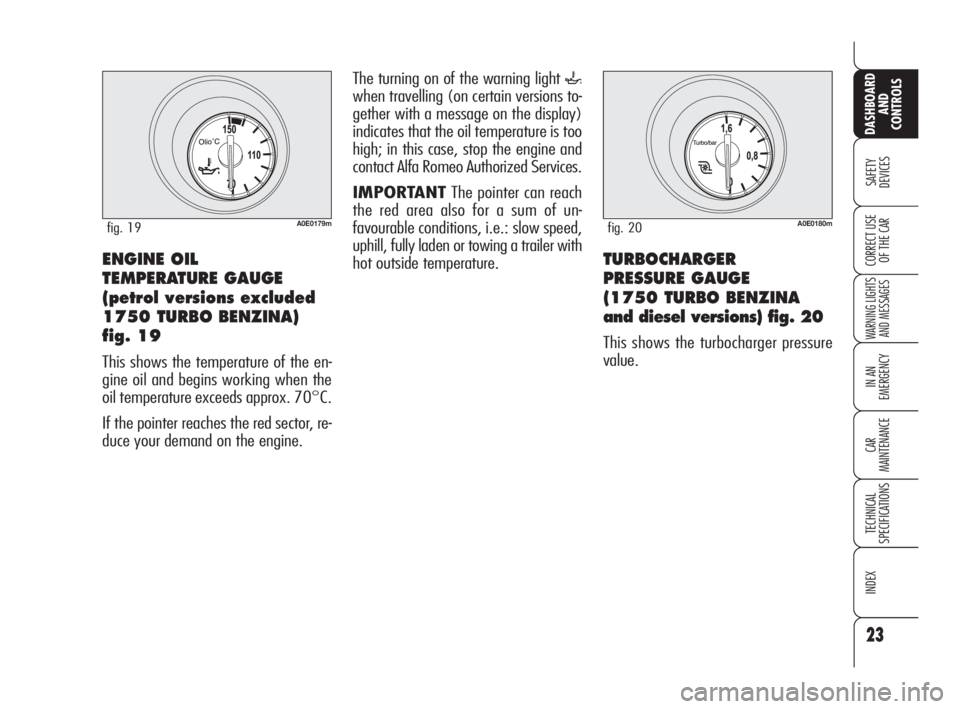
23
SAFETY
DEVICES
WARNING LIGHTS
AND MESSAGES
IN AN
EMERGENCY
CAR
MAINTENANCE
TECHNICAL
SPECIFICATIONS
INDEX
DASHBOARD
AND
CONTROLS
CORRECT USE
OF THE CAR
The turning on of the warning light `
when travelling (on certain versions to-
gether with a message on the display)
indicates that the oil temperature is too
high; in this case, stop the engine and
contact Alfa Romeo Authorized Services.
IMPORTANTThe pointer can reach
the red area also for a sum of un-
favourable conditions, i.e.: slow speed,
uphill, fully laden or towing a trailer with
hot outside temperature.
ENGINE OIL
TEMPERATURE GAUGE
(petrol versions excluded
1750 TURBO BENZINA)
fig. 19
This shows the temperature of the en-
gine oil and begins working when the
oil temperature exceeds approx. 70°C.
If the pointer reaches the red sector, re-
duce your demand on the engine.
A0E0179mfig. 19A0E0180mfig. 20
TURBOCHARGER
PRESSURE GAUGE
(1750 TURBO BENZINA
and diesel versions) fig. 20
This shows the turbocharger pressure
value.
001-045 Alfa 159 GB 8-04-2009 10:48 Pagina 23
Page 159 of 331
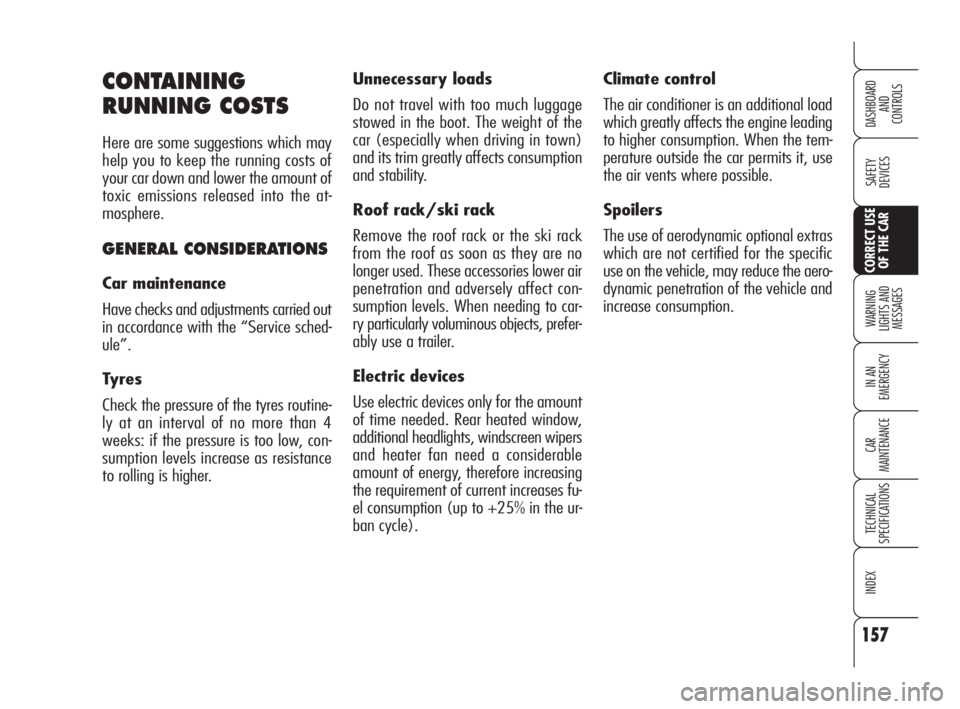
157
SAFETY
DEVICES
WARNING
LIGHTS AND
MESSAGES
IN AN
EMERGENCY
CAR
MAINTENANCE
TECHNICAL
SPECIFICATIONS
INDEX
DASHBOARD
AND
CONTROLS
CORRECT USE
OF THE CAR
Climate control
The air conditioner is an additional load
which greatly affects the engine leading
to higher consumption. When the tem-
perature outside the car permits it, use
the air vents where possible.
Spoilers
The use of aerodynamic optional extras
which are not certified for the specific
use on the vehicle, may reduce the aero-
dynamic penetration of the vehicle and
increase consumption. Unnecessary loads
Do not travel with too much luggage
stowed in the boot. The weight of the
car (especially when driving in town)
and its trim greatly affects consumption
and stability.
Roof rack/ski rack
Remove the roof rack or the ski rack
from the roof as soon as they are no
longer used. These accessories lower air
penetration and adversely affect con-
sumption levels. When needing to car-
ry particularly voluminous objects, prefer-
ably use a trailer.
Electric devices
Use electric devices only for the amount
of time needed. Rear heated window,
additional headlights, windscreen wipers
and heater fan need a considerable
amount of energy, therefore increasing
the requirement of current increases fu-
el consumption (up to +25% in the ur-
ban cycle).CONTAINING
RUNNING COSTS
Here are some suggestions which may
help you to keep the running costs of
your car down and lower the amount of
toxic emissions released into the at-
mosphere.
GENERAL CONSIDERATIONS
Car maintenance
Have checks and adjustments carried out
in accordance with the “Service sched-
ule”.
Tyres
Check the pressure of the tyres routine-
ly at an interval of no more than 4
weeks: if the pressure is too low, con-
sumption levels increase as resistance
to rolling is higher.
149-164 Alfa 159 GB 8-04-2009 10:51 Pagina 157
Page 167 of 331
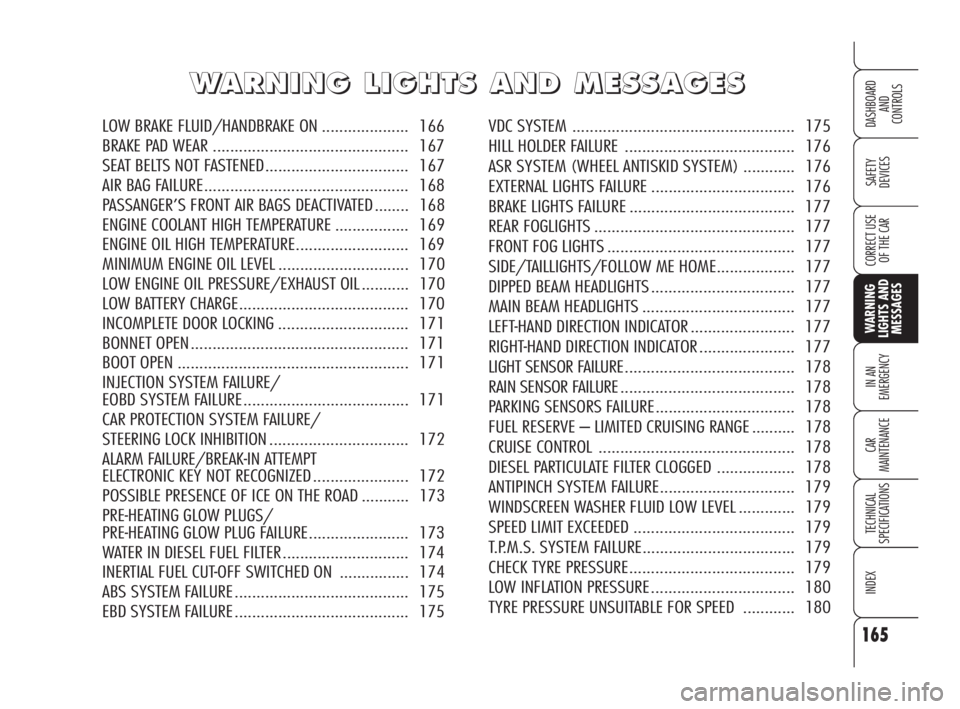
165
SAFETY
DEVICES
IN AN
EMERGENCY
CAR
MAINTENANCE
TECHNICAL
SPECIFICATIONS
INDEX
CORRECT USE
OF THE CAR
DASHBOARD
AND
CONTROLS
WARNING
LIGHTS AND
MESSAGES
W W
A A
R R
N N
I I
N N
G G
L L
I I
G G
H H
T T
S S
A A
N N
D D
M M
E E
S S
S S
A A
G G
E E
S S
LOW BRAKE FLUID/HANDBRAKE ON .................... 166
BRAKE PAD WEAR ............................................. 167
SEAT BELTS NOT FASTENED................................. 167
AIR BAG FAILURE............................................... 168
PASSANGER’S FRONT AIR BAGS DEACTIVATED ........ 168
ENGINE COOLANT HIGH TEMPERATURE ................. 169
ENGINE OIL HIGH TEMPERATURE.......................... 169
MINIMUM ENGINE OIL LEVEL .............................. 170
LOW ENGINE OIL PRESSURE/EXHAUST OIL ........... 170
LOW BATTERY CHARGE....................................... 170
INCOMPLETE DOOR LOCKING .............................. 171
BONNET OPEN.................................................. 171
BOOT OPEN..................................................... 171
INJECTION SYSTEM FAILURE/
EOBD SYSTEM FAILURE...................................... 171
CAR PROTECTION SYSTEM FAILURE/
STEERING LOCK INHIBITION ................................ 172
ALARM FAILURE/BREAK-IN ATTEMPT
ELECTRONIC KEY NOT RECOGNIZED ...................... 172
POSSIBLE PRESENCE OF ICE ON THE ROAD ........... 173
PRE-HEATING GLOW PLUGS/
PRE-HEATING GLOW PLUG FAILURE....................... 173
WATER IN DIESEL FUEL FILTER ............................. 174
INERTIAL FUEL CUT-OFF SWITCHED ON ................ 174
ABS SYSTEM FAILURE ........................................ 175
EBD SYSTEM FAILURE ........................................ 175VDC SYSTEM ................................................... 175
HILL HOLDER FAILURE ....................................... 176
ASR SYSTEM (WHEEL ANTISKID SYSTEM) ............ 176
EXTERNAL LIGHTS FAILURE ................................. 176
BRAKE LIGHTS FAILURE ...................................... 177
REAR FOGLIGHTS.............................................. 177
FRONT FOG LIGHTS........................................... 177
SIDE/TAILLIGHTS/FOLLOW ME HOME.................. 177
DIPPED BEAM HEADLIGHTS ................................. 177
MAIN BEAM HEADLIGHTS ................................... 177
LEFT-HAND DIRECTION INDICATOR ........................ 177
RIGHT-HAND DIRECTION INDICATOR ...................... 177
LIGHT SENSOR FAILURE....................................... 178
RAIN SENSOR FAILURE........................................ 178
PARKING SENSORS FAILURE................................ 178
FUEL RESERVE – LIMITED CRUISING RANGE .......... 178
CRUISE CONTROL ............................................. 178
DIESEL PARTICULATE FILTER CLOGGED .................. 178
ANTIPINCH SYSTEM FAILURE............................... 179
WINDSCREEN WASHER FLUID LOW LEVEL ............. 179
SPEED LIMIT EXCEEDED ..................................... 179
T.P.M.S. SYSTEM FAILURE................................... 179
CHECK TYRE PRESSURE...................................... 179
LOW INFLATION PRESSURE................................. 180
TYRE PRESSURE UNSUITABLE FOR SPEED ............ 180
165-180 Alfa 159 GB 3-12-2009 14:09 Pagina 165
Page 172 of 331
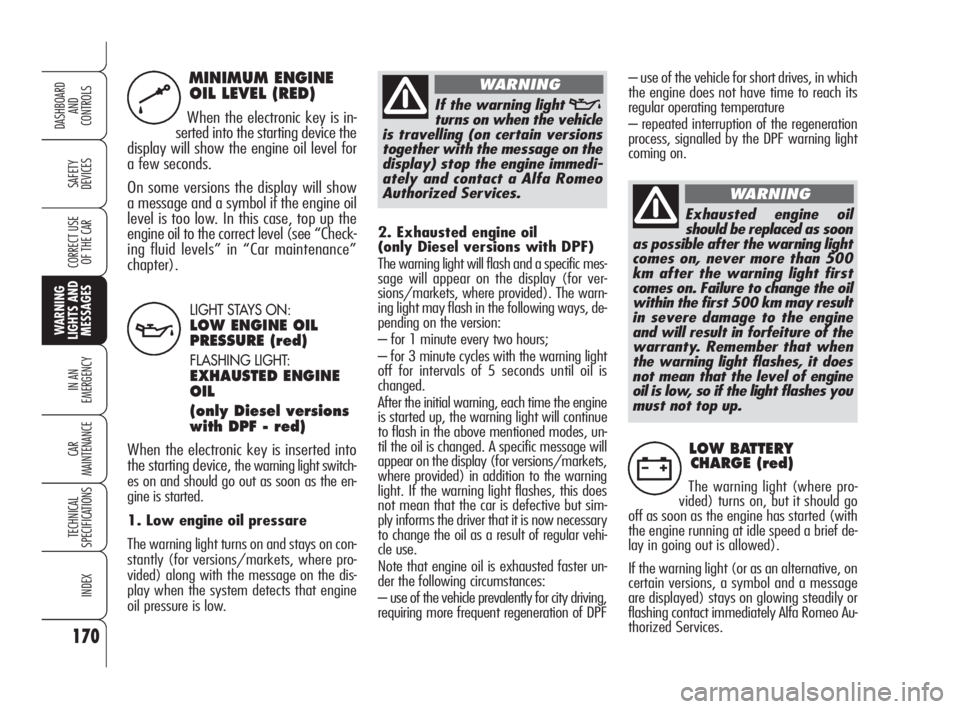
170
SAFETY
DEVICES
IN AN
EMERGENCY
CAR
MAINTENANCE
TECHNICAL
SPECIFICATIONS
INDEX
CORRECT USE
OF THE CAR
DASHBOARD
AND
CONTROLS
WARNING
LIGHTS AND
MESSAGES
LIGHT STAYS ON:
LOW ENGINE OIL
PRESSURE (red)
FLASHING LIGHT:
EXHAUSTED ENGINE
OIL
(only Diesel versions
with DPF - red)
When the electronic key is inserted into
the starting device,
the warning light switch-
es on and should go out as soon as the en-
gine is started.
1. Low engine oil pressare
The warning light turns on and stays on con-
stantly (for versions/markets, where pro-
vided) along with the message on the dis-
play when the system detects that engine
oil pressure is low.– use of the vehicle for short drives, in which
the engine does not have time to reach its
regular operating temperature
– repeated interruption of the regeneration
process, signalled by the DPF warning light
coming on.
LOW BATTERY
CHARGE (red)
The warning light (where pro-
vided) turns on, but it should go
off as soon as the engine has started (with
the engine running at idle speed a brief de-
lay in going out is allowed).
If the warning light (or as an alternative, on
certain versions, a symbol and a message
are displayed) stays on glowing steadily or
flashing contact immediately Alfa Romeo Au-
thorized Services.w
v
If the warning light vturns on when the vehicle
is travelling (on certain versions
together with the message on the
display) stop the engine immedi-
ately and contact a Alfa Romeo
Authorized Services.
WARNING
2. Exhausted engine oil
(only Diesel versions with DPF)
The warning light will flash and a specific mes-
sage will appear on the display (for ver-
sions/markets, where provided). The warn-
ing light may flash in the following ways, de-
pending on the version:
– for 1 minute every two hours;
– for 3 minute cycles with the warning light
off for intervals of 5 seconds until oil is
changed.
After the initial warning, each time the engine
is started up, the warning light will continue
to flash in the above mentioned modes, un-
til the oil is changed. A specific message will
appear on the display (for versions/markets,
where provided) in addition to the warning
light. If the warning light flashes, this does
not mean that the car is defective but sim-
ply informs the driver that it is now necessary
to change the oil as a result of regular vehi-
cle use.
Note that engine oil is exhausted faster un-
der the following circumstances:
– use of the vehicle prevalently for city driving,
requiring more frequent regeneration of DPF
MINIMUM ENGINE
OIL LEVEL (RED)
When the electronic key is in-
serted into the starting device the
display will show the engine oil level for
a few seconds.
On some versions the display will show
a message and a symbol if the engine oil
level is too low. In this case, top up the
engine oil to the correct level (see “Check-
ing fluid levels” in “Car maintenance”
chapter).k
Exhausted engine oil
should be replaced as soon
as possible after the warning light
comes on, never more than 500
km after the warning light first
comes on. Failure to change the oil
within the first 500 km may result
in severe damage to the engine
and will result in forfeiture of the
warranty. Remember that when
the warning light flashes, it does
not mean that the level of engine
oil is low, so if the light flashes you
must not top up.
WARNING
165-180 Alfa 159 GB 3-12-2009 14:09 Pagina 170
Page 229 of 331
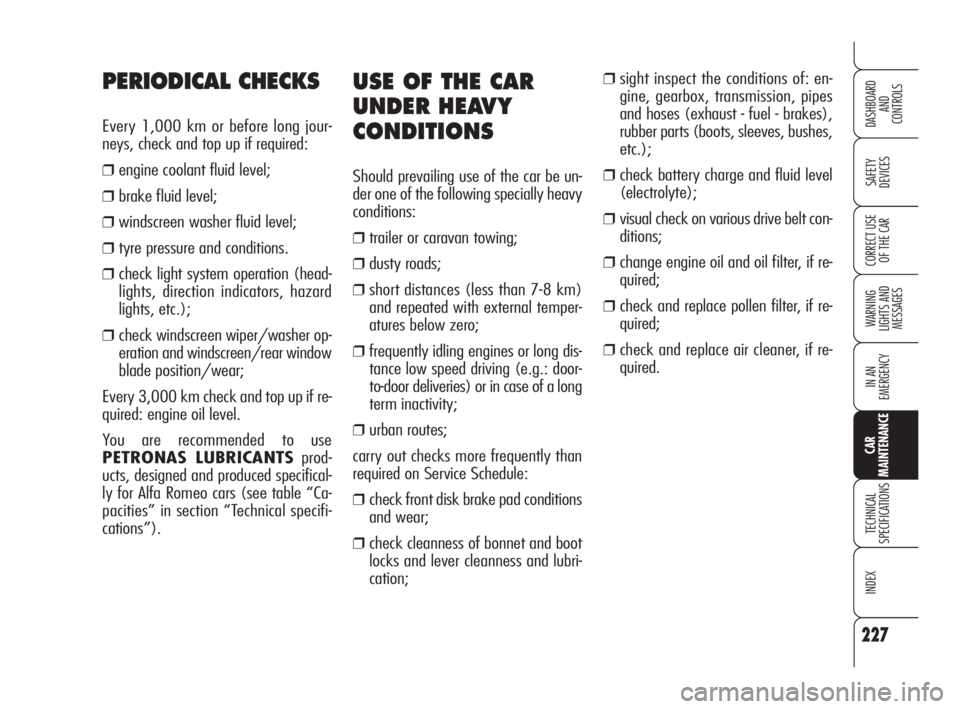
USE OF THE CAR
UNDER HEAVY
CONDITIONS
Should prevailing use of the car be un-
der one of the following specially heavy
conditions:
❒ trailer or caravan towing;
❒ dusty roads;
❒ short distances (less than 7-8 km)
and repeated with external temper-
atures below zero;
❒ frequently idling engines or long dis-
tance low speed driving (e.g.: door-
to-door deliveries) or in case of a long
term inactivity;
❒ urban routes;
carry out checks more frequently than
required on Service Schedule:
❒ check front disk brake pad conditions
and wear;
❒ check cleanness of bonnet and boot
locks and lever cleanness and lubri-
cation;
❒ sight inspect the conditions of: en-
gine, gearbox, transmission, pipes
and hoses (exhaust - fuel - brakes),
rubber parts (boots, sleeves, bushes,
etc.);
❒ check battery charge and fluid level
(electrolyte);
❒ visual check on various drive belt con-
ditions;
❒ change engine oil and oil filter, if re-
quired;
❒ check and replace pollen filter, if re-
quired;
❒ check and replace air cleaner, if re-
quired.
PERIODICAL CHECKS
Every 1,000 km or before long jour-
neys, check and top up if required:
❒engine coolant fluid level;
❒brake fluid level;
❒windscreen washer fluid level;
❒ tyre pressure and conditions.
❒ check light system operation (head-
lights, direction indicators, hazard
lights, etc.);
❒ check windscreen wiper/washer op-
eration and windscreen/rear window
blade position/wear;
Every 3,000 km check and top up if re-
quired: engine oil level.
You are recommended to use
PETRONAS LUBRICANTSprod-
ucts, designed and produced specifical-
ly for Alfa Romeo cars (see table “Ca-
pacities” in section “Technical specifi-
cations”).
CAR
MAINTENANCE
DASHBOARD
AND
CONTROLS
CORRECT USE
OF THE CAR
INDEX
TECHNICAL
SPECIFICATIONS
IN AN
EMERGENCY
WARNING
LIGHTS AND
MESSAGES
SAFETY
DEVICES
227
223-248 Alfa 159 GB 3-12-2009 14:11 Pagina 227